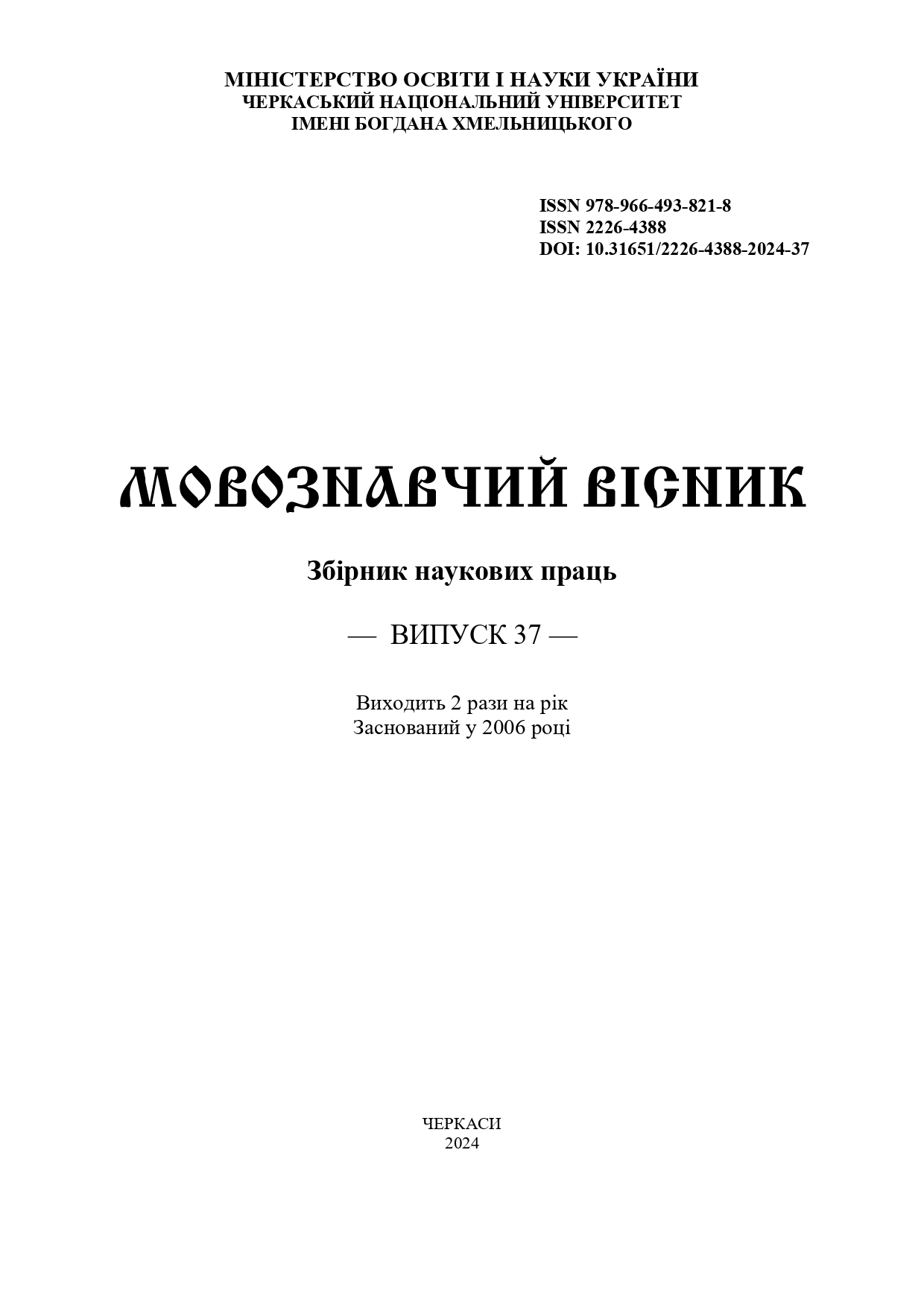WRITTEN HISTORY OF VERBAL PREFIXATION IN THE OLD UKRAINIAN LITERARY LANGUAGE OF THE 14TH – 17TH CENTURIES
Main Article Content
Abstract
The article investigates the structural and motivational aspect of verb prefixation recorded in the Old Ukrainian literary language of the 14th – 17th centuries. The linguistic marker of verb ellipsis is established, which implies the possibility of double motivation, which is based on a combination of morphological, onomasiological and semasiological approaches, taking into account the etymological segment of prefixes. The purpose of the article is to consider the internal structure of the prefixal verb subsystem of the Old Ukrainian language of the 14th – 17th centuries and to establish the motivational segment in derived derivatives, which forms the word-formation model of nomination.
The word-forming model of structural-motivational and functional factors of the verb subsystem of the Old Ukrainian literary language of the 14th – 17th centuries, produced by the word-forming potential and means of its implementation, is revealed. The productivity of prefixal word-forming nominals is characterized by word-forming prefixal models that are structurally and semantically motivated by the onomasiological basis of the root verb. Historical word-formation studies show that in the language of written monuments of the 14th – 17th centuries there is a clear tendency to increase the role of prefixation in the verb segment, which naturally affects the activity of individual prefixes.
Verb prefixes perform a species-recognition function, that is, they lead to a change in the type of basic verbs and modify the meaning of the state under various qualitative functions. In many groups of verbs, prefixes performed with additional meanings that differed from prepositional structures. The paradigmatic relationship of verb prefixes to the syntactic constructions in which they were segmented revealed the model of affixation as a semantic-word-forming process. The relationship of prefixes with some prepositions and their change in the meaning of the verb have an impact on the entire semantic structure of the sentence in which they are located, not only in content but also in form. Verbal prefixation as a method of word formation arose in the Proto-Slavic period, and the prefix systems of modern Slavic languages are its natural continuation.
Article Details
References
Білоусенко П. І. Історія суфіксальної системи українського іменника (назви осіб чоловічого роду). Київ : КДПІ, 1993. 214 с.
Верхратский І. Про говор галицких Лемків. Львів,1902. 480 с.
Вступ до порівняльно-історичного вивчення слов’янських мов / [наук. ред. О. Мельничук]. Київ : Наукова думка, 1966. 588 с.
Галаур С. П. Явище префіксально-прийменникової кореляції: історія вивчення та перспективи дослідження. Наукові записки. Серія «Філологічна». Острог : Видавництво Національного університету «Острозька академія», 2008. Вип. 10. С. 60–70.
Зацний Ю. А. Розвиток словникового складу англійської мови в 80–90-ті роки ХХ століття : дис.…доктора філол. наук : 10.02.04 / Київський ун-т ім. Т. Шевченка. Київ, 1999. 409 с.
Зубань О. М. Статус конфікса у системі української мови. Слов’янські мови і сучасний світ. Київ : Видавничо-поліграфічний центр «Київський університет», 2000. С. 115–121.
Клименко Н., Карпіловська Є. Словотвірна морфеміка сучасної української літературної мови. Київ : Ін-т мовознавства ім. О. О. Потебні НАН України, 1998. 161 с.
Колібаба Л. Проблема зв’язку дії та словотвірних категорій дієслів. Науковий вісник Херсонського державного університету. Серія «Лінгвістика»: зб. наук. праць. Херсон, 2006. Вип. ІІІ. С. 45–52.
Коца Р. О. Формування префіксальної та конфіксальної систем прикметника української мови (XI–XX ст.). Київ : Наук. думка, 2017. 277 с.
Степаненко М. І. Морфемна будова предиката й структурно значеннєва завершеність речення. Актуальні проблеми граматики : зб. наук. праць/ ред. кол.: В. Ожоган та ін. Наукові записки Кіровогр. держ. пед. унту ім. В. Винниченка. Кіровоград, 1997. Вип. 2. С. 153–157.
Синявський О. Норми української літературної мови. Львів : Укрвидав, 1941. 363 с.
Сімович В. Граматика української мови для самонавчання та в допомогу шкільній науці. 2-ге вид. з одмінами й додатками. Київ; Ляйпціh, 1919. 584 с.
Словотвір сучасної української літературної мови [І. І. Ковалик, Л. О. Родніна, А. П. Грищенко та ін.; відп. ред. М. А. Жовтобрюх]. Київ : Наук. думка, 1979. 406 с.
СУМ: Словник української мови ХVI – першої половини ХVII ст. : у 28 вип. [відп. ред. Д. Гринчишин та ін.]. Львів, 1994 –2005. Вип. 1–12.
Тимченко Є. Матеріали до Словника писемної та книжної української мови ХV–ХVІІІ ст. : у 2 кн. / [Упор. В. В. Німчук, Г. І. Лиса]. Київ; Нью-Йорк, 2002–2003. [Пам’ятки української мови. Серія словників]. Кн. 1–2.
Meyer Ch. F. Introducing English linguistics. Cambridge: Cambridge University Press. 2009. 259 p.

